BIM Implementation in Construction: A Case Study of Venetian Casino
VerifiedAdded on 2023/04/22
|7
|1456
|253
Case Study
AI Summary
This case study examines the implementation of Building Information Modeling (BIM) in the Venetian Casino project in Macau, focusing on how BIM technology was used to address and resolve conflicts during the detailed design stage. The project involved the construction of a complex podium façade with Balinese style, comprising eighteen interconnected themed parts. Initial challenges included integration problems between the concrete structure and the glassfibre Reinforced Concrete (GRC) facades, leading to delays. To mitigate these issues, a BIM 3D modeling approach was adopted in the second phase, involving a team of experts who identified and resolved clashes between architectural and structural elements before handing over the blueprint to the contractor. The BIM team coalesced 3D models from the architect and 2D drawings from the structural engineer, identifying conflicting information and missing details. A coordination workshop facilitated by the client addressed doubts and updated the 3D model, leading to better understanding and resolution of issues. The case study concludes that while BIM improves project implementation, it also introduces new challenges in design development and payment schedules, emphasizing the need for a complete 3D model before construction to avoid clashes.

Running head: CASE STUDY OF BIM IMPLEMENTATION
Case Study of BIM Implementation
Name
Institutional Affiliation
Case Study of BIM Implementation
Name
Institutional Affiliation
Paraphrase This Document
Need a fresh take? Get an instant paraphrase of this document with our AI Paraphraser
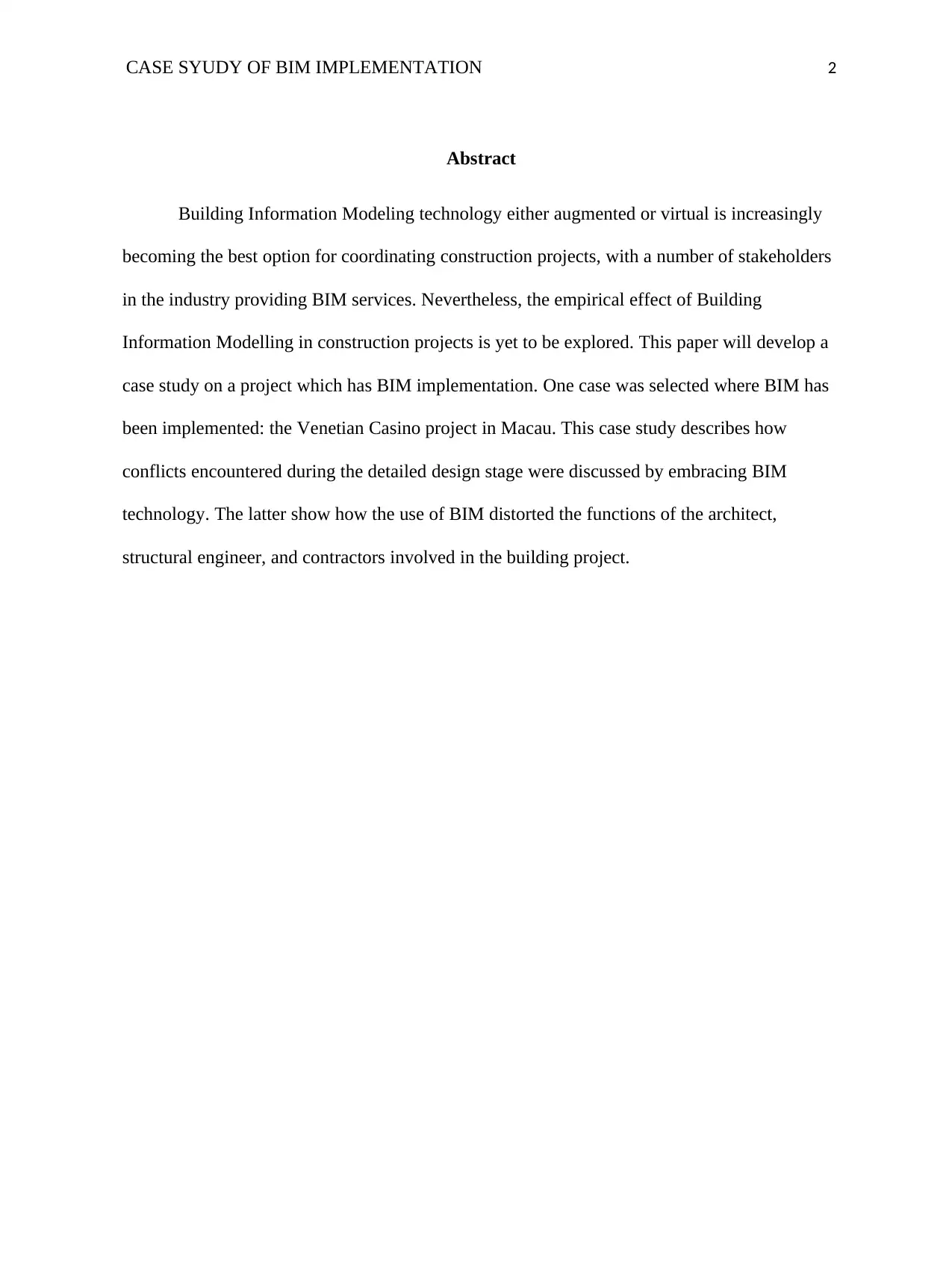
CASE SYUDY OF BIM IMPLEMENTATION 2
Abstract
Building Information Modeling technology either augmented or virtual is increasingly
becoming the best option for coordinating construction projects, with a number of stakeholders
in the industry providing BIM services. Nevertheless, the empirical effect of Building
Information Modelling in construction projects is yet to be explored. This paper will develop a
case study on a project which has BIM implementation. One case was selected where BIM has
been implemented: the Venetian Casino project in Macau. This case study describes how
conflicts encountered during the detailed design stage were discussed by embracing BIM
technology. The latter show how the use of BIM distorted the functions of the architect,
structural engineer, and contractors involved in the building project.
Abstract
Building Information Modeling technology either augmented or virtual is increasingly
becoming the best option for coordinating construction projects, with a number of stakeholders
in the industry providing BIM services. Nevertheless, the empirical effect of Building
Information Modelling in construction projects is yet to be explored. This paper will develop a
case study on a project which has BIM implementation. One case was selected where BIM has
been implemented: the Venetian Casino project in Macau. This case study describes how
conflicts encountered during the detailed design stage were discussed by embracing BIM
technology. The latter show how the use of BIM distorted the functions of the architect,
structural engineer, and contractors involved in the building project.
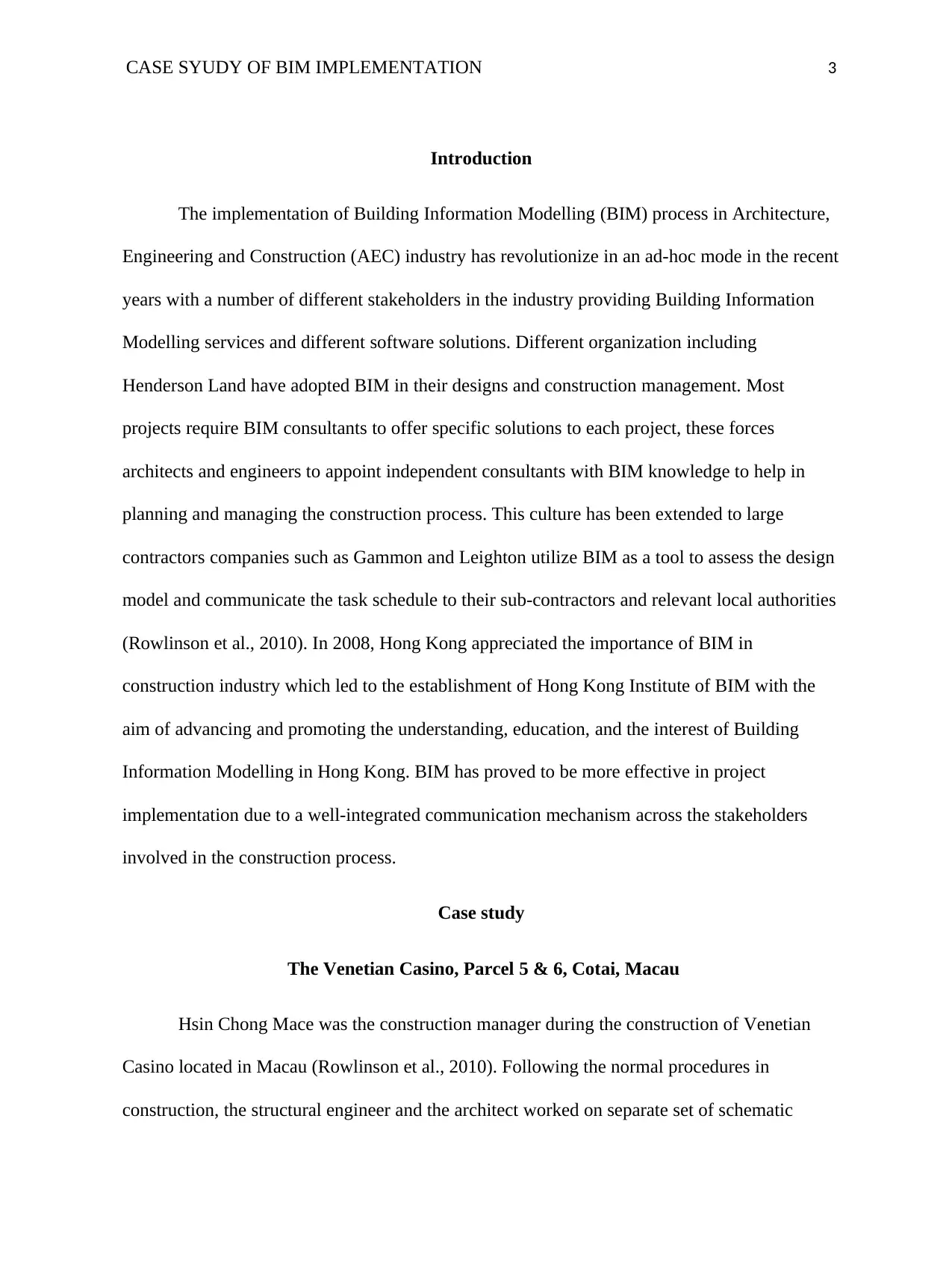
CASE SYUDY OF BIM IMPLEMENTATION 3
Introduction
The implementation of Building Information Modelling (BIM) process in Architecture,
Engineering and Construction (AEC) industry has revolutionize in an ad-hoc mode in the recent
years with a number of different stakeholders in the industry providing Building Information
Modelling services and different software solutions. Different organization including
Henderson Land have adopted BIM in their designs and construction management. Most
projects require BIM consultants to offer specific solutions to each project, these forces
architects and engineers to appoint independent consultants with BIM knowledge to help in
planning and managing the construction process. This culture has been extended to large
contractors companies such as Gammon and Leighton utilize BIM as a tool to assess the design
model and communicate the task schedule to their sub-contractors and relevant local authorities
(Rowlinson et al., 2010). In 2008, Hong Kong appreciated the importance of BIM in
construction industry which led to the establishment of Hong Kong Institute of BIM with the
aim of advancing and promoting the understanding, education, and the interest of Building
Information Modelling in Hong Kong. BIM has proved to be more effective in project
implementation due to a well-integrated communication mechanism across the stakeholders
involved in the construction process.
Case study
The Venetian Casino, Parcel 5 & 6, Cotai, Macau
Hsin Chong Mace was the construction manager during the construction of Venetian
Casino located in Macau (Rowlinson et al., 2010). Following the normal procedures in
construction, the structural engineer and the architect worked on separate set of schematic
Introduction
The implementation of Building Information Modelling (BIM) process in Architecture,
Engineering and Construction (AEC) industry has revolutionize in an ad-hoc mode in the recent
years with a number of different stakeholders in the industry providing Building Information
Modelling services and different software solutions. Different organization including
Henderson Land have adopted BIM in their designs and construction management. Most
projects require BIM consultants to offer specific solutions to each project, these forces
architects and engineers to appoint independent consultants with BIM knowledge to help in
planning and managing the construction process. This culture has been extended to large
contractors companies such as Gammon and Leighton utilize BIM as a tool to assess the design
model and communicate the task schedule to their sub-contractors and relevant local authorities
(Rowlinson et al., 2010). In 2008, Hong Kong appreciated the importance of BIM in
construction industry which led to the establishment of Hong Kong Institute of BIM with the
aim of advancing and promoting the understanding, education, and the interest of Building
Information Modelling in Hong Kong. BIM has proved to be more effective in project
implementation due to a well-integrated communication mechanism across the stakeholders
involved in the construction process.
Case study
The Venetian Casino, Parcel 5 & 6, Cotai, Macau
Hsin Chong Mace was the construction manager during the construction of Venetian
Casino located in Macau (Rowlinson et al., 2010). Following the normal procedures in
construction, the structural engineer and the architect worked on separate set of schematic
⊘ This is a preview!⊘
Do you want full access?
Subscribe today to unlock all pages.

Trusted by 1+ million students worldwide
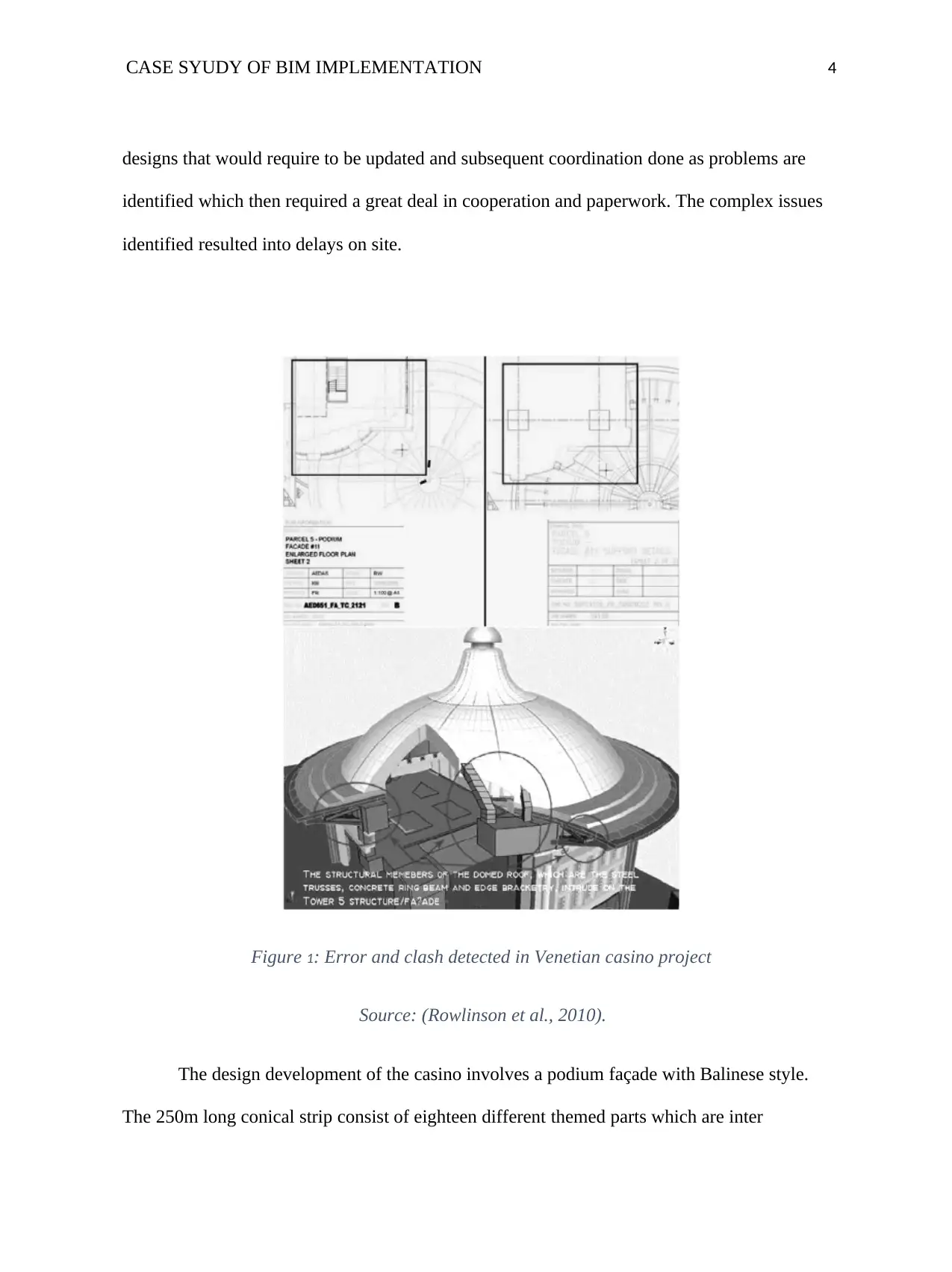
CASE SYUDY OF BIM IMPLEMENTATION 4
designs that would require to be updated and subsequent coordination done as problems are
identified which then required a great deal in cooperation and paperwork. The complex issues
identified resulted into delays on site.
Figure 1: Error and clash detected in Venetian casino project
Source: (Rowlinson et al., 2010).
The design development of the casino involves a podium façade with Balinese style.
The 250m long conical strip consist of eighteen different themed parts which are inter
designs that would require to be updated and subsequent coordination done as problems are
identified which then required a great deal in cooperation and paperwork. The complex issues
identified resulted into delays on site.
Figure 1: Error and clash detected in Venetian casino project
Source: (Rowlinson et al., 2010).
The design development of the casino involves a podium façade with Balinese style.
The 250m long conical strip consist of eighteen different themed parts which are inter
Paraphrase This Document
Need a fresh take? Get an instant paraphrase of this document with our AI Paraphraser
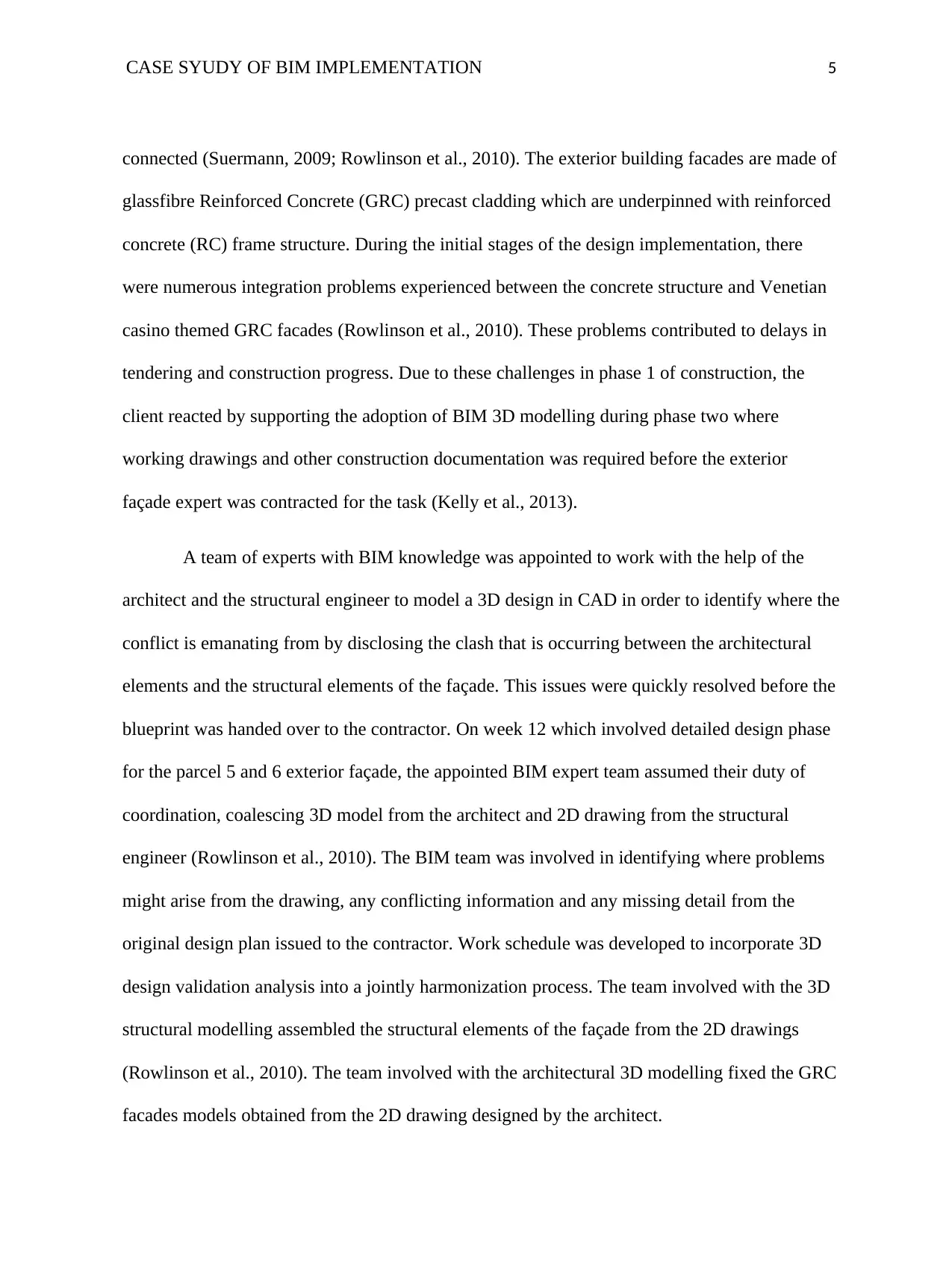
CASE SYUDY OF BIM IMPLEMENTATION 5
connected (Suermann, 2009; Rowlinson et al., 2010). The exterior building facades are made of
glassfibre Reinforced Concrete (GRC) precast cladding which are underpinned with reinforced
concrete (RC) frame structure. During the initial stages of the design implementation, there
were numerous integration problems experienced between the concrete structure and Venetian
casino themed GRC facades (Rowlinson et al., 2010). These problems contributed to delays in
tendering and construction progress. Due to these challenges in phase 1 of construction, the
client reacted by supporting the adoption of BIM 3D modelling during phase two where
working drawings and other construction documentation was required before the exterior
façade expert was contracted for the task (Kelly et al., 2013).
A team of experts with BIM knowledge was appointed to work with the help of the
architect and the structural engineer to model a 3D design in CAD in order to identify where the
conflict is emanating from by disclosing the clash that is occurring between the architectural
elements and the structural elements of the façade. This issues were quickly resolved before the
blueprint was handed over to the contractor. On week 12 which involved detailed design phase
for the parcel 5 and 6 exterior façade, the appointed BIM expert team assumed their duty of
coordination, coalescing 3D model from the architect and 2D drawing from the structural
engineer (Rowlinson et al., 2010). The BIM team was involved in identifying where problems
might arise from the drawing, any conflicting information and any missing detail from the
original design plan issued to the contractor. Work schedule was developed to incorporate 3D
design validation analysis into a jointly harmonization process. The team involved with the 3D
structural modelling assembled the structural elements of the façade from the 2D drawings
(Rowlinson et al., 2010). The team involved with the architectural 3D modelling fixed the GRC
facades models obtained from the 2D drawing designed by the architect.
connected (Suermann, 2009; Rowlinson et al., 2010). The exterior building facades are made of
glassfibre Reinforced Concrete (GRC) precast cladding which are underpinned with reinforced
concrete (RC) frame structure. During the initial stages of the design implementation, there
were numerous integration problems experienced between the concrete structure and Venetian
casino themed GRC facades (Rowlinson et al., 2010). These problems contributed to delays in
tendering and construction progress. Due to these challenges in phase 1 of construction, the
client reacted by supporting the adoption of BIM 3D modelling during phase two where
working drawings and other construction documentation was required before the exterior
façade expert was contracted for the task (Kelly et al., 2013).
A team of experts with BIM knowledge was appointed to work with the help of the
architect and the structural engineer to model a 3D design in CAD in order to identify where the
conflict is emanating from by disclosing the clash that is occurring between the architectural
elements and the structural elements of the façade. This issues were quickly resolved before the
blueprint was handed over to the contractor. On week 12 which involved detailed design phase
for the parcel 5 and 6 exterior façade, the appointed BIM expert team assumed their duty of
coordination, coalescing 3D model from the architect and 2D drawing from the structural
engineer (Rowlinson et al., 2010). The BIM team was involved in identifying where problems
might arise from the drawing, any conflicting information and any missing detail from the
original design plan issued to the contractor. Work schedule was developed to incorporate 3D
design validation analysis into a jointly harmonization process. The team involved with the 3D
structural modelling assembled the structural elements of the façade from the 2D drawings
(Rowlinson et al., 2010). The team involved with the architectural 3D modelling fixed the GRC
facades models obtained from the 2D drawing designed by the architect.
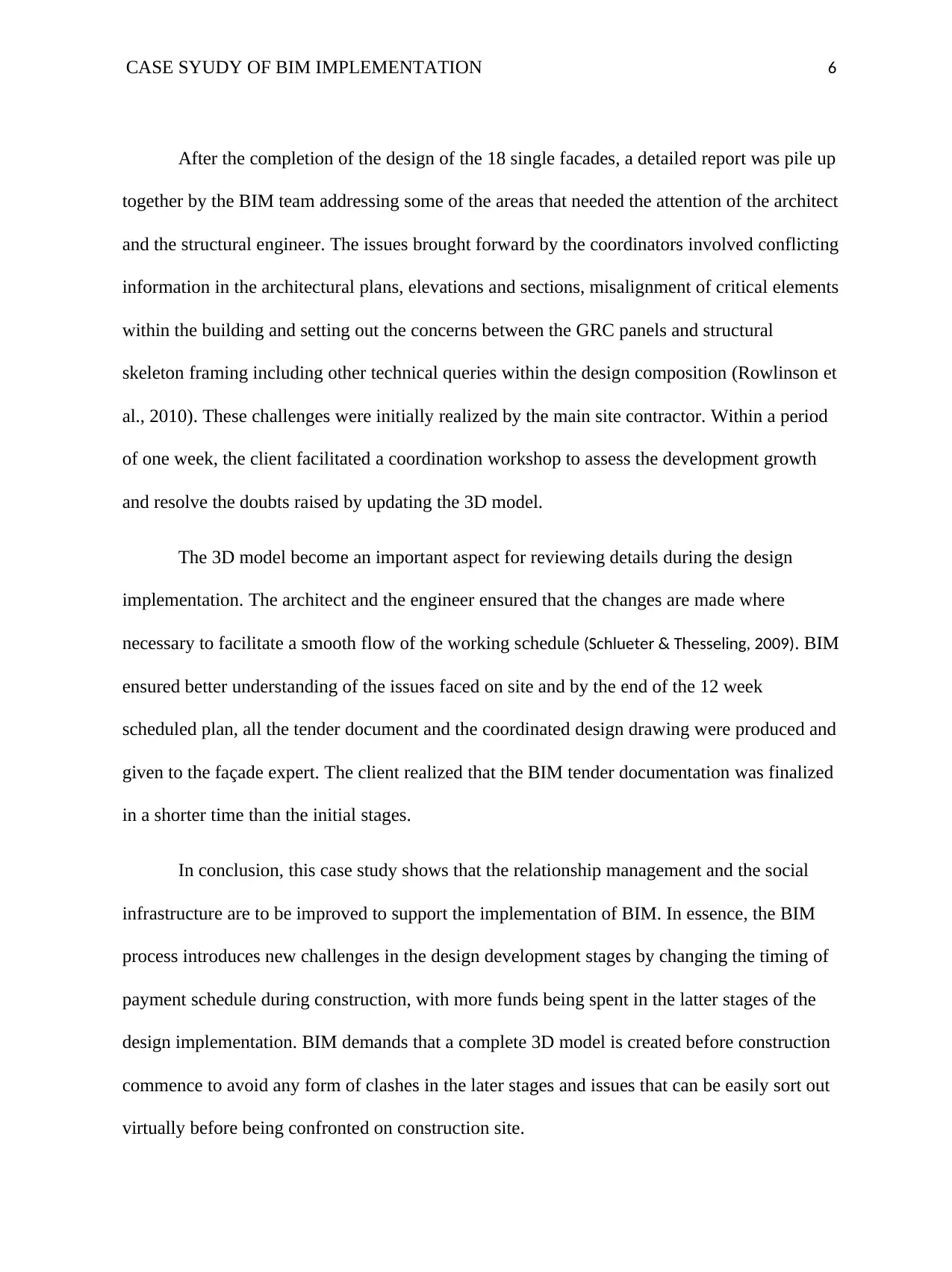
CASE SYUDY OF BIM IMPLEMENTATION 6
After the completion of the design of the 18 single facades, a detailed report was pile up
together by the BIM team addressing some of the areas that needed the attention of the architect
and the structural engineer. The issues brought forward by the coordinators involved conflicting
information in the architectural plans, elevations and sections, misalignment of critical elements
within the building and setting out the concerns between the GRC panels and structural
skeleton framing including other technical queries within the design composition (Rowlinson et
al., 2010). These challenges were initially realized by the main site contractor. Within a period
of one week, the client facilitated a coordination workshop to assess the development growth
and resolve the doubts raised by updating the 3D model.
The 3D model become an important aspect for reviewing details during the design
implementation. The architect and the engineer ensured that the changes are made where
necessary to facilitate a smooth flow of the working schedule (Schlueter & Thesseling, 2009). BIM
ensured better understanding of the issues faced on site and by the end of the 12 week
scheduled plan, all the tender document and the coordinated design drawing were produced and
given to the façade expert. The client realized that the BIM tender documentation was finalized
in a shorter time than the initial stages.
In conclusion, this case study shows that the relationship management and the social
infrastructure are to be improved to support the implementation of BIM. In essence, the BIM
process introduces new challenges in the design development stages by changing the timing of
payment schedule during construction, with more funds being spent in the latter stages of the
design implementation. BIM demands that a complete 3D model is created before construction
commence to avoid any form of clashes in the later stages and issues that can be easily sort out
virtually before being confronted on construction site.
After the completion of the design of the 18 single facades, a detailed report was pile up
together by the BIM team addressing some of the areas that needed the attention of the architect
and the structural engineer. The issues brought forward by the coordinators involved conflicting
information in the architectural plans, elevations and sections, misalignment of critical elements
within the building and setting out the concerns between the GRC panels and structural
skeleton framing including other technical queries within the design composition (Rowlinson et
al., 2010). These challenges were initially realized by the main site contractor. Within a period
of one week, the client facilitated a coordination workshop to assess the development growth
and resolve the doubts raised by updating the 3D model.
The 3D model become an important aspect for reviewing details during the design
implementation. The architect and the engineer ensured that the changes are made where
necessary to facilitate a smooth flow of the working schedule (Schlueter & Thesseling, 2009). BIM
ensured better understanding of the issues faced on site and by the end of the 12 week
scheduled plan, all the tender document and the coordinated design drawing were produced and
given to the façade expert. The client realized that the BIM tender documentation was finalized
in a shorter time than the initial stages.
In conclusion, this case study shows that the relationship management and the social
infrastructure are to be improved to support the implementation of BIM. In essence, the BIM
process introduces new challenges in the design development stages by changing the timing of
payment schedule during construction, with more funds being spent in the latter stages of the
design implementation. BIM demands that a complete 3D model is created before construction
commence to avoid any form of clashes in the later stages and issues that can be easily sort out
virtually before being confronted on construction site.
⊘ This is a preview!⊘
Do you want full access?
Subscribe today to unlock all pages.

Trusted by 1+ million students worldwide
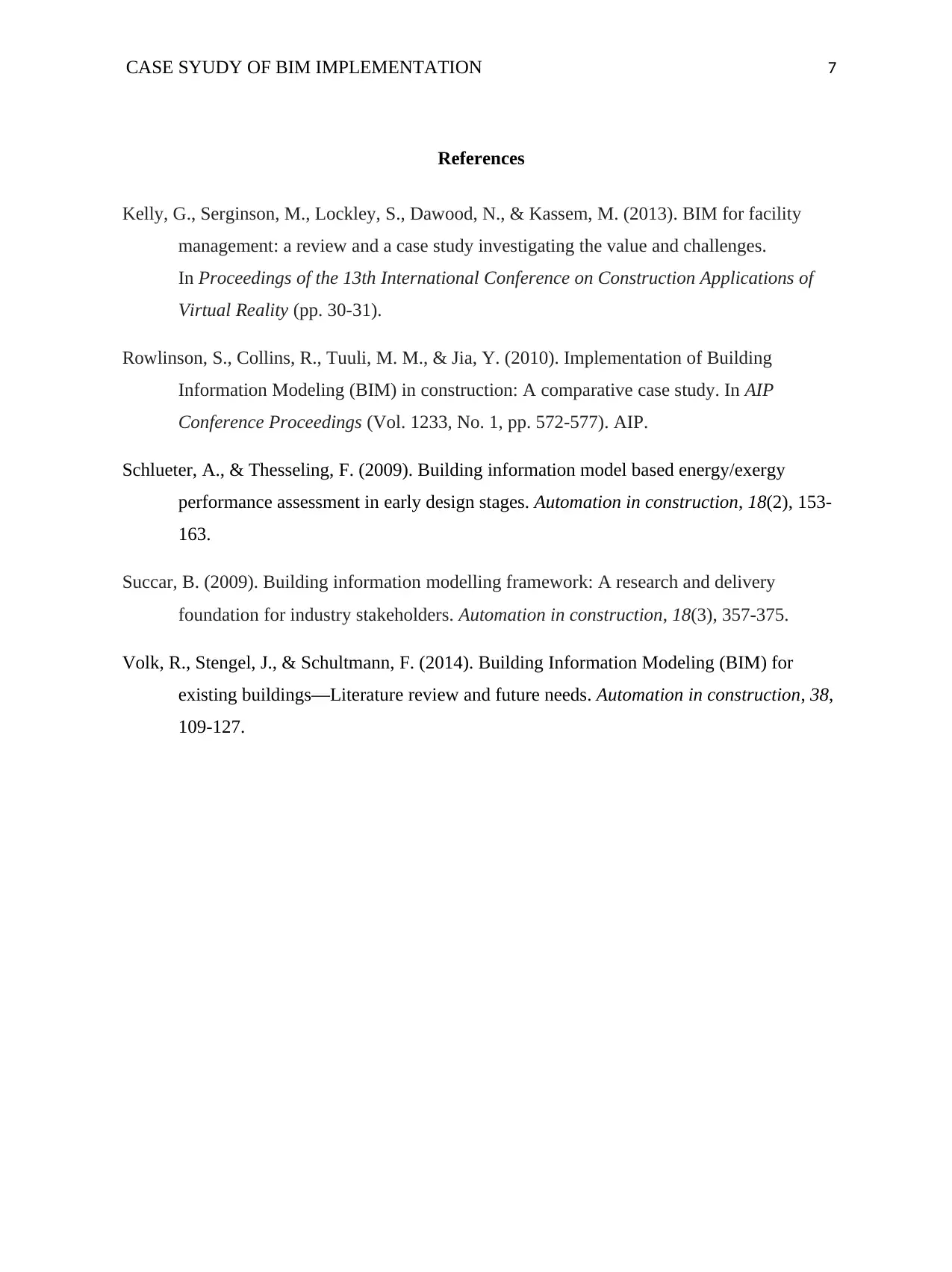
CASE SYUDY OF BIM IMPLEMENTATION 7
References
Kelly, G., Serginson, M., Lockley, S., Dawood, N., & Kassem, M. (2013). BIM for facility
management: a review and a case study investigating the value and challenges.
In Proceedings of the 13th International Conference on Construction Applications of
Virtual Reality (pp. 30-31).
Rowlinson, S., Collins, R., Tuuli, M. M., & Jia, Y. (2010). Implementation of Building
Information Modeling (BIM) in construction: A comparative case study. In AIP
Conference Proceedings (Vol. 1233, No. 1, pp. 572-577). AIP.
Schlueter, A., & Thesseling, F. (2009). Building information model based energy/exergy
performance assessment in early design stages. Automation in construction, 18(2), 153-
163.
Succar, B. (2009). Building information modelling framework: A research and delivery
foundation for industry stakeholders. Automation in construction, 18(3), 357-375.
Volk, R., Stengel, J., & Schultmann, F. (2014). Building Information Modeling (BIM) for
existing buildings—Literature review and future needs. Automation in construction, 38,
109-127.
References
Kelly, G., Serginson, M., Lockley, S., Dawood, N., & Kassem, M. (2013). BIM for facility
management: a review and a case study investigating the value and challenges.
In Proceedings of the 13th International Conference on Construction Applications of
Virtual Reality (pp. 30-31).
Rowlinson, S., Collins, R., Tuuli, M. M., & Jia, Y. (2010). Implementation of Building
Information Modeling (BIM) in construction: A comparative case study. In AIP
Conference Proceedings (Vol. 1233, No. 1, pp. 572-577). AIP.
Schlueter, A., & Thesseling, F. (2009). Building information model based energy/exergy
performance assessment in early design stages. Automation in construction, 18(2), 153-
163.
Succar, B. (2009). Building information modelling framework: A research and delivery
foundation for industry stakeholders. Automation in construction, 18(3), 357-375.
Volk, R., Stengel, J., & Schultmann, F. (2014). Building Information Modeling (BIM) for
existing buildings—Literature review and future needs. Automation in construction, 38,
109-127.
1 out of 7
Related Documents
Your All-in-One AI-Powered Toolkit for Academic Success.
+13062052269
info@desklib.com
Available 24*7 on WhatsApp / Email
![[object Object]](/_next/static/media/star-bottom.7253800d.svg)
Unlock your academic potential
Copyright © 2020–2025 A2Z Services. All Rights Reserved. Developed and managed by ZUCOL.





